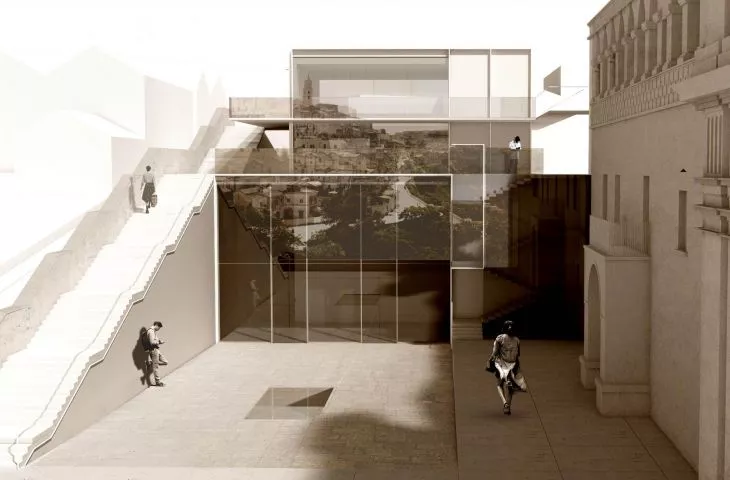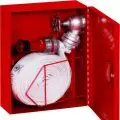Marta Stachurska, a graduate of the Cracow University of Technology, has created a project for the Museum of Culture in Matera, one of the oldest cities in the world. Her proposal takes special account of the architectural, archaeological and landscape context of the Italian city.
Matera, a UNESCO World Heritage city, is a unique place. Its uniqueness is evidenced by the fact that for hundreds of years people have lived there in houses hollowed out of the rocks. Researchers consider the city a great example of cave settlements in Europe. Until recently, Matera's residents lived far from civilization, devoid of utilities. The Italian government decided to revitalize the town and open it to modernity, a process that continues today.
An important task was to incorporate the building into the historic buildings
© Marta Stachurska
new building in a historic site
Marta Stachurska, fitting into the city's revitalization process, designed Matera's museum using numerous historical and urban planning analyses. The project was created with special attention to the architectural, archaeological and landscape context of the site. The author addressed several important topics:
- the problem of erecting new buildings in strictly built-up historic districts of old European cities,
- construction in respect of the history and culture of the place,
- thecombination of new architecture with historical buildings, with special attention to and introduction of technological and ecological innovations.
The museum is located in the historic part of Matera
© Marta Stachurska
The design task was to carve out a new usable space in the strict urban fabric - the historic buildings. An important aspect was the least possible interference with the existing surroundings. Thus, the new building had to subordinate to the neighboring monuments, not dominate and fit into the context of the surroundings and at the same time be a value in itself. An important element shaping the project was the famous houses carved into the rocks, which are a tourist attraction for the entire region.
Guided by these assumptions, the author proposed the Museum of Culture as a space hidden underground. A significant part of the building is a block inscribed in the hollow rock. Interestingly, the building has only one elevation (front). The form of the museum is a resultant of the shape and size of the plot and the conditions resulting from the location - the close proximity of historic buildings and the vantage point of the city skyline located in the area.
a significant part of the building is located underground
© Marta Stachurska
structural assumptions and function of the building
In the central part of the mass, the author placed a reinforced concrete shaft. On the outer face of the wall it is flanked by vertical communication - open stairs. This cuboid is the heart of the building both formally and functionally. It also fulfills an important structural function - made entirely in reinforced concrete technology, it provides support for the large coffered ceiling covering the entire establishment. The form of the encircling spiral of communication alludes to the numerous terrain stairs found in Matera, connecting the many levels of the site.
design process
© Marta Stachurska
The designed facility is a multifunctional complex with a predominantly cultural and didactic function. The already mentioned central rectangular core is divided internally into several floors, where a different function is located on each. Two of the five floors protrude above the hollowed-out rock body, with the last floor housing an observation deck. The structural tower is encircled by a vertical communication that spirals around it, first inside the building to then transition into an open external staircase. Around the main shaft, a designated place for functions: representative and cultural (exhibition hall) - they fill the hollowed-out space in the rock.
As the author says:
Thefunctions intermingle in places, they are not clearly designated and separated from each other, and so, for example, using the communication function, we can admire the museum's exhibition, so communication is also a cultural function. Similarly, the boundary between the representative and cultural function is blurred, where the foyer is open to the exhibition hall and together they constitute a whole.
circular architecture - innovation and ecology
museum fits into a hollow rock
© Marta Stachurska
The project was created in accordance with the idea of a circular economy, meaning the creation of a living environment based on the judicious use of resources, compatible with nature, using environmentally friendly technologies. The most important assumptions inherent in this trend are:
- respect for the terrain, fitting into the context of the place - the mass of the museum is hidden in relation to the surrounding buildings, and three of its four walls are the natural raw material of the face of the hollow rock,
- taking into account the cultural context, the traditions of local construction,
- use of local materials- stone and slabs, including those obtained from the demolition of the previous building system,
- reduction and reuse - both of the materials already mentioned, but also of the terrain (e.g., soil from the excavation for embankment in another part of the plot) and volume (use of the existing layout),
- energy efficiency manifested in the minimization of heat loss and passive solar energy harvesting - turning the fully glazed front facade to the south, so the building is heated mainly by the sun's rays.
TheMuseum of Culture is a thesis entitled. "Circular Architecture - Museum of Culture at the Sant' Agostino Monastery Establishment in Matera" carried out at the Faculty of Architecture of the Cracow University of Technology under the direction of Prof. Andrzej Kadłuczka and Dr. Barbara Zin. Marta Stachurska's project has been qualified for the finals of this year's edition of the Zbyszek Zawistowski "Diploma of the Year" Award. The results will be known on October 9!
compiled by: Dobrawa Bies
illustrations courtesy of Marta Stachurska














































